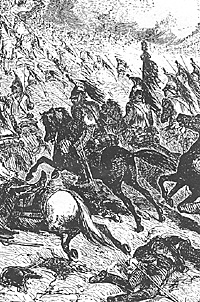
To complete this study, the two sides' swords and swordsmanship deserve comment, as it reflect the different attitudes, doctrines and training. Although melees were few, one side would usually break and flee before impact; fear of their opponents ability, and confidence in their own weapons and skill were significant factors in whether troopers confidently charged home, or hesitated and broke at the prospect.
That melees were few is well illustrated by Tomkinson's
comment: "This is the only instance I ever met with of two bodies
of cavalry in opposition, and both standing, for invariably as I have
observed it, one or the other runs away."
[22]
Even in pursuit, relatively few casualties were inflicted, as
controlling one's mount and protecting oneself took up most of a
trooper's concentration. Also, surrender in a widely dispersed
crowd was far easier during the pursuit compared to a packed
melee, [23] and even in a
melee, killing one's opponent was the last consideration after
controlling one's mount, defending oneself and listening for orders.
Few actual casualties, but many prisoners were usual in a cavalry
combat. Lieutenant Hall makes it clear that fear was sharper than a
sword in combat: 'But their alarm was greater than their hurt.'
[24]
For both sides, "les armes blanches", swords and sabre,
were the principle arms; pistols and carbines being seldom used,
limited usually to skirmishing and outpost work. While the
weapons were basically similar, there was a vital difference in
underlying doctrine, for the French favoured the thrust, while the
British adhered rigidly to the cut.
Dragoons were equipped with a long, straight sword,
sharpened at both edge and point, while light cavalry carried a
curved sabre. Both French heavy and light cavalry were trained to
use the point of their weapons. The thrust of the French cavalry
sword was much feared, as they tended to prove far more fatal
than a cut. Lieutenant Hall commented on a skirmish between
British and French Dragoons at Fuentes de Onero: 'their swords,
which were straight and pointed were capable of inflicting a severe
wound.' [25]
The British preference for the cut as opposed to the thrust
was reflected in both design and skill. Le Marchant's sword drill
expressly stressed the cut: 'The thrust has only one mode of
execution, whether applied to cavalry or infantry ... for which
reason the point should seldom or never be given in the attack.'
[26]
While there seems to have been mixed opinions over the
merits of the cut against the thrust,
[27] training rather than
design or skill seems to have been at fault, as the K.G.L. were
renowned for the effectiveness of their swordsmanship and they
used Le Marchant's drill and sabre.
The British Dragoon sword was a poor weapon, for it had
a relatively short 35 inch blade (compared to the French Dragoon
sword's blade of 39 inches), making it a poor thrusting weapon,
and its hatchet point designed for the cut made it top heavy and
poorly balanced, hence awkward to cut at a mounted opponent. It
was only truly effective against infantry.
[28]
Many British officers also felt that the light cavalry sabre
was a poor weapon, and it is true its very curved and broad blade
was only suitable for the stroke. The Journal of the Royal
Dragoons comments in 1812: 'A Light Dragoon sabre was hardly
capable of killing' [29] and
from the enormous proportion of wounded to killed in actual
cavalry melees on both sides, it is clear that both sides' curved
sabres were better suited to maim than slay. Yet, Le Marchant
seems to have been justified in favouring the cut, for Captain
Parquin of the 20th Chasseurs; a Cheval records that although most
British blows missed (Le Marchant cannot be blamed for poor
training of his ideas): 'If the edge of the blade found its mark only
once, it was a terrible blow, and it was not unusual to see an arm
cut clean from the body.' [30]
More British and French Cavalry Part 2
More British and French Cavalry Part 1 (AoN 11)
Comparative Performance
The Charge
Comparison of Swords and Swordsmanship
Conclusion, Notes, and Bibliography
Introduction
General Background
Recruitment, Officers, and Training: British
Recruitment, Officers, and Training: French
Comparative Performance
Back to Napoleonic Notes and Queries #12 Table of Contents
Back to Age of Napoleon List of Issues
Back to MagWeb Master List of Magazines
© Copyright 1993 by Partizan Press.
This article appears in MagWeb.com (Magazine Web) on the Internet World Wide Web.
Other articles from military history and related magazines are available at http://www.magweb.com